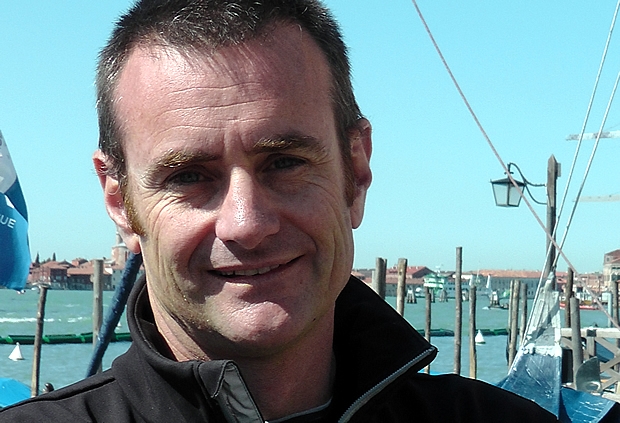
AC72 design
One of the most illustrious posts in yachting is running the design team for Emirates Team New Zealand, a role previously filled by revered figures such as Tom Schnackenberg and Andy Claughton. Today Technical Director for the Kiwi team is Nick Holroyd, although he is far from being a new boy, having joined the team in 1997 in the build-up to the Team New Zealand’s successful 2000 defence, continuing with the team in their 2003 and 2007 America’s Cup campaigns before working on the all-conquering Emirates Team New Zealand TP52 and their less all-conquering Camper VO70.
For their AC72, the Emirates Team New Zealand design team is something of an all-star cast including Guillaume Verdier and his team, Gino Morrelli and Pete Melvin in California and Canadian C-Class designer Steve Killing, along with the likes of VPP expert Dan Bernisconi formerly with Alinghi and Head of Vehicle Dynamics at McLaren F1. However since for the 34th America’s Cup is entering a new realm with wingsail catamarans, much new blood has been required. So the Kiwi design team now includes for example Hal Youngren who wrote aerodynamic prediction software for Skunkworks and was involved in the Stealth fighter program and now does a lot of wing section optimisation for the team.
The new AC72 will be something. Holroyd says the weight of the platform of the Kiwi AC72 will be around 4.5 tonnes, but structurally it is complex with two hulls having to be joined by cross beams and presumably some sort of fore and aft structure running down the centreline including the bowsprit and to maintain fore and aft stiffness.
“In terms of the really detailed composite engineering, there’s about three times as much composite work in the structure [compared to a V5 boat],” Holroyd says. “There are obviously two hulls instead of one, but you then have the whole cross-structure linking it together, so the level of complexity and the sheer number of hours to do that design work is huge.”
With around 30 on the design side alone, of which 26-27 are full time, Holroyd says that over a 2-2.5 year campaign that equates to around 70-80 man years of design time going into their AC72s, or around 10x the resource that they concentrated on their VO70 design. “The level of detail into which you can go inside the Cup environment and the resource and the tools that you can bring to it are a different border of magnitude.”
While the catamaran configuration is new to Cup Worlds, this is almost the insignificant part of the design problem next to the wing, appendages, etc. “Occasionally we joke in the team that the hulls are just a delivery mechanisms for the rest of the boat, but no, they are still an important part of the equation,” says Holroyd.
But even the wing isn’t the vast challenge that one might expect. While it is relatively new technology in the yachting arena, wings have been around for some time on aeroplanes... “Putting a wing into the sailing environment is not that common, but at the same time there are hugely well developed tools available," Holroyd continues. "All the university research into flight and aircraft and so on over a span of the last 100 years has really culminated in us being able to walk into putting a wing on a boat and picking up very mature, very reliable production tools.”
However while an aircraft which will have a fairly narrow range of payloads and will have to deliver roughly the same amount of lift, on a multihull the equivalent is the righting moment which reaches its maximum just as the windward hull lifts off the water, after which the rig starts having to be depowered. The wing then to twist and bend into a much wider range of geometries than an aircraft would be subject to.
Compared to an equivalent soft sail, the AC72 solid wing will develop almost twice the power in light airs while at the top end of conditions the rig can be depowered much more effectively than a soft sail (which is why wing rigs are not as scary in big conditions as you might first imagine).
“They are hugely controllable, but when they get out of control they are capable of huge power,” says Holroyd. “The maximum lift coefficient of a conventional mainsail is maybe 1-1.2. The maximum lift power co-efficient of a two element wing might be 2.4-2.6, so you have got literally double the power potentially available out of it. But it is all the traditional transitional things, the bear aways, etc where it can go from in control to out of control and really bite you on the arse, in a heartbeat...”
However the wing offers the ability to be able to manage the power more effectively. “If you want to make it go faster as the wind increases, and get more force out of it, you have to drop the centre of effort of the sail plan lower towards the platform, With the wing you have this huge ability to do that in a way you could never do with a soft sail because they have very low power settings and the soft sail will flap and become very drained.”
While the wing is relatively easy to handle, the physics of what the crew will have to deal with is fairly staggering. Holroyd points out that the V5 boats had around 25 tonne metres of righting moment with 16 crew, or roughly 1.5 tonne metres of power for each crewman to handle. By coincidence the AC45s have a similar ratio to the V5 boats with around 7 tonne metres of righting moment. “But the guys would say that the multihulls are a far more athletic boat... However on the AC72 we have 11 people but the righting moment blossomed to 55 tonne metres, so you have gone from the V5 boat or AC45 dealing with 1.5 ton metres per person, to suddenly dealing with about 5.5 ton metres per person...”
A significant difference between the AC45 and AC72, apart from the size, is the speed and the way the boats are sailed downwind with the apparent wind expected to be even further forward with the bigger cat. “On the AC45s the apparent wind angle is still relatively wide. On tThe 72 it is much finer and it will be sailing downwind at apparent angles of around 25°, so your top speed was potentially much higher. To put into perspective, the old V5 boats sailed upwind at 18° apparent.”
Another way at looking at the power is the wind speed required for hull flying: on the AC45 it is around 7.5-8 knots, whereas on the AC72 it will be just over 5 knots, says Holroyd.
A significant unknown for design teams at present is the time of day racing will take place on San Francisco Bay for next year’s Louis Vuitton Cup and America’s Cup matches. “In San Francisco the wind speed builds quite steadily through the afternoon, so in a typical August the wind is around 10 knots at midday and will continue to build by 1.5-2 knots/hour all the way through the afternoon until 1700 when it’s blowing 20-22 knots. So getting that start time information is pretty critical to us, because we have to optimise the boat to a fairly specific range,” says Holroyd.
It seems likely that this decision will be driven by the TV scheduling rather than anything else, but knowing whether racing is likely to be in 10 knots or over 20 will be of major significance to put it mildly.
In addition Holroyd points out that on San Francisco Bay there is also a strong tidal component on the race course. “So wind with tide you have very flat water, almost abnormally flat for the wind speed, and with wind against tide you get a very short, steep wave stack. So again, the dynamic loadings etc that puts on the structure become the driver in the whole programme.”
The only AC72 wing to have emerged into public view is the one Artemis Racing has fitted to their modified ORMA 60. Holroyd says that the Swedish team's wing is “a different solution to where we are at. I have a feeling that maybe their designers are looking a little more for upwind efficiency rather than raw down wind power perhaps, vis-à-vis where I think we are at.” According to Holroyd he can tell this by the ratio between the relative sizes of the front and rear flaps and where that puts your most efficient point on the lift curve. “My guess is that they may be a little more efficient than us in low lift-type conditions. We may ultimately be able to pull more power up out in high lift conditions.”
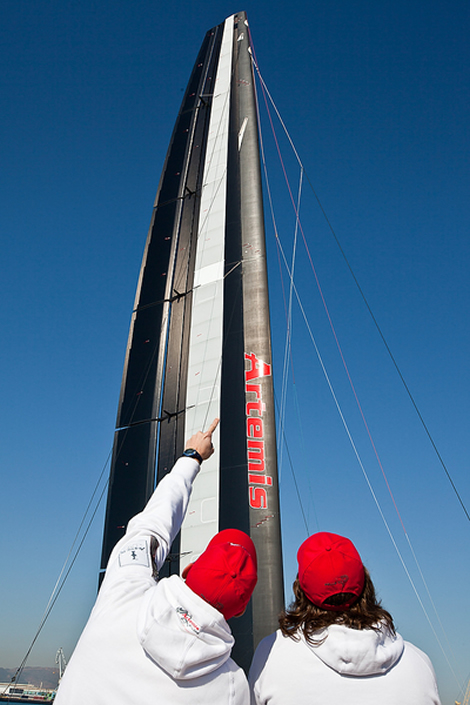
So with the more powerful wings are foresails still going to be required? "The 45s are less powerful in terms of the wing area they have available, and they are all using sails. I think the big driver is actually tacking, getting out of a dial- ups, when you are going to need something to drive the bow. I think the guys also find the boats a little easier to sail with a jib on as well. One of the things about a wing is that it doesn’t flap, so a lot of the tactile cues you are used to looking at as a trimmer otherwise aren’t there. So having a little soft sail on the front which luffs and has telltails and the things you are still working with actually helps the guys sail the boat a little better. For sure there are times uprange when wing alone is undoubtedly more efficient, but I think there are concessions to efficiency in order to get around the course and I think the jibs will probably evolve quite small, exactly as they have done on the 45s."
So a boy racer question - how fast could the AC72 boat go? “It is not going to be in speed record contention, but it is going to be pretty quick,” says Holroyd. “Upwind speeds could easily be approaching 25 knots and VMG numbers, shooting from the hip, a 16-17 type knot number. Downwind, right at the top end, you will be seeing speeds potentially approaching 40 knots and I think what is going to be quite impressive is we are used to seeing smaller multihulls, the AC45s etc, gybing through quite big angles, whereas I think the 72s not only are going to be very fast, but they are actually going to sail very very deep because of their ability to keep the apparent wind forward.”
However as with all multihulls straight line speed is only one issue and a great deal of focus is certain to be on how quickly the AC72s can be made to turn corners, with more rocker so that they are less prone getting caught in irons along with other manoeuvre-aiding devices. “The Race Committee has already stated that the courses they will set will require boats to gybe at least three times down the run. A three mile run is expected to take around six minutes, so you are going to come around the top mark, buoy deploy, manoeuvre, you’ve got three dives gybes and a bottom mark rounding to keep it to complete - all in six minutes.
“So if you are on a boat doing 30+ knots downwind most days and your bottom speed through a gybe is 12-15 knots and then you have to heat it up and come down, etc, your losses through gybes relative to the boat going straight, will be in the order of 100s of metres. So there are the dynamics of making boards easy to handle, etc and absolutely there will be concessions to be made in terms of getting the boat around the course in the minimum time versus the power limits that you have on board.”
Quite interesting is comparing the AC33 multihulls to the new 72s. On the former they were permitted (after a great deal of machinations by the New York Supreme Court) to fit engines of typically 100kW output to trim sails and help in manoeuvres, etc on board the giant multihulls. However without these aids on the AC72 they have to rely on manual power. According to Holroyd a good grinder has a peak power of around 800w, and a continuous power of 400-500w. So if all of the AC72 crew is grinding then that is still only around 6kW...
Fortunately the wing requires less power in handling than an equivalent soft sail. “On a conventional sail you need a huge amount of membrane tension to achieve a sail that is very very flat and that means huge sheet load and an awful lot of power," says Holroyd. "One of the things that makes these boats more manageable with a wing than with a soft sail is that the speed at which you can trim the wing is relatively much higher. In the 33rd AC, Oracle always looked a lot more locked in sailing upwind and I think part of that was just the speed with which they can could trim the wing and trim the power on and off.”
But Holroyd is under no illusion that when designing their AC72 if through the ergonomics of their sail handling systems and the way the wing is set-up and can be controlled, greater efficiency of the crew can be achieved across the wind range, then that is going to create a vastly quicker package than any minimal increase in aero-dynamic optimisation might achieve.
The potential for capsize is a real threat but one which he says they prefer not to think about overly. “We tease Dalts that we don’t own enough chase boats, because but if you cartwheel one of these things you are going to need one chase boat to pick up each hull, and a couple to pick up the crew, and one for the wing and one for the platform! So capsize is not something you want to spend a huge amount of time thinking about.”
Obviously there are elements of the design that can help prevent this. In French offshore multihull design for example there has been a trend to moving the centre of effort of the rig aft to prevent pitchpoling. But with the length-limited AC72 capsize prevention is more likely to be seen in design of the bows as well as the orientation and positioning of the daggerboards, so they create enough vertical lift to keep the bows up during the all-important bearway at the top mark, while providing enough lateral resistance to prevent leeway. However there is an element of risk to using the boards to create lift as Holroyd says: “As the boat accelerates away after a bear away at the top mark, you are getting lift from the foil to keep the bow up, but if you get past a certain point, the bow starts to go down, and then the angle of attack on your foil decreases and you are in this vicious circle where the dynamic stability from the foil is disappearing just when you need it the most.... Trying to find the right balance between displacement/buoyancy-type forces preventing capsize or pitchpoling and using the foils to help out with that, is an interesting part of the equation. Compared to where we were with the monohulls, it is a whole new dimension to the sport for us as a designers.”
Another aspect of designing an AC72 that is perhaps less than obvious is the effect of stiffness/weight on performance. “The dynamic stiffness of the platform has a huge impact when a gust hits the rig, and the rig starts to develop more power. So does the boat accelerate or does the boat just start to flex? It is almost impossible to model upfront what the performance gain is for increasing stiffness, so for example you are left with a design decision of ‘do I reduce the windage of the platform or do I make it stiffer?’ That becomes a really hard trade off to make, because it is quite easy to estimate the windage gain from making the frontal area of the platform smaller for example. So I can say from a pure windage point of view I know that is going to be ten seconds to a race faster."
Still with 70-80 man years to play with, one assumes that they must by now have a pretty reason handle on this.
The first crop of AC72s is expected to be launched soon after the 1 July deadline permitted for team under the Protocol for the 34th America's Cup.

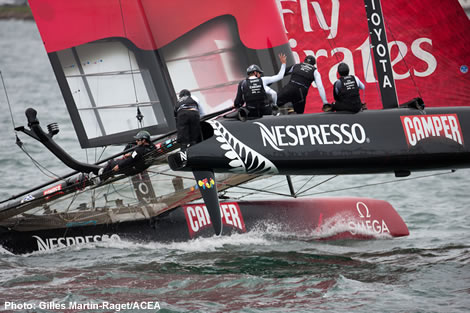
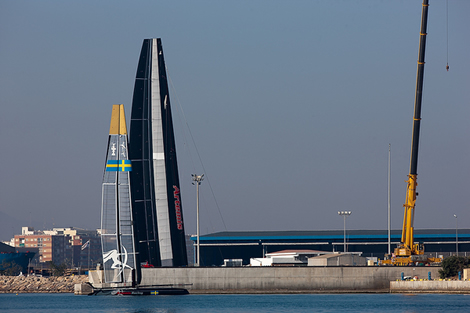
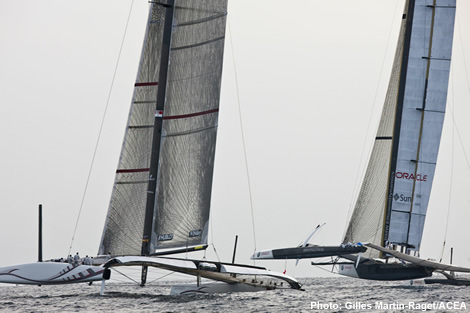







Latest Comments
Mats Ohlsson 24/06/2012 - 17:43
The stiffness issue is certainly very interesting. A stiffer structure develops much higher point loads, so it has to be heavier to prevent breakage. The opposite applies to a softer structure. What is interesting is the reasoning that the first puff just creates flex. Yes, but the flex is stored energy (like compressing a spring), so do you actually lose enougt to justify the weight of added stiffness???Add a comment - Members log in